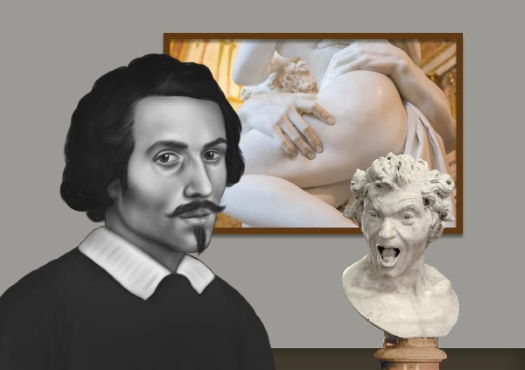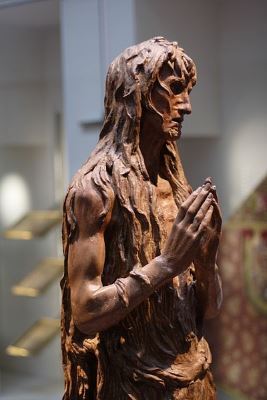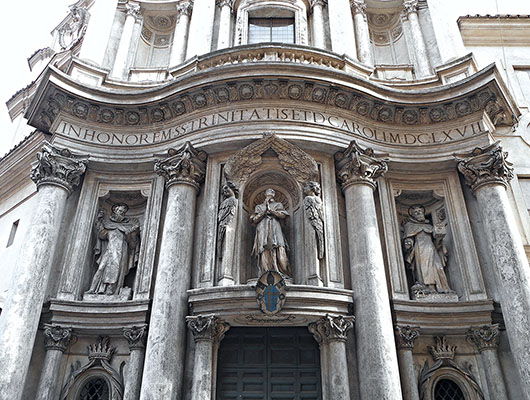Summary of Gian Lorenzo Bernini
Passion, above all else, ruled Italian sculptor and architect Gian Lorenzo Bernini. His extreme religious piety combined with a lifelong study of the sculptural form led to the introduction of a dynamic and exuberant style, focused on emotional expressionism, which perfectly embodied the Baroque period. Like Michelangelo before him, he became a master of marble, while remaining equally fluent in other media. His manner and vision was so innovative, it pioneered a new era in European sculpture that has influenced the form to this day.
Bernini was also a leading figure in the emergence of Roman Baroque architecture along with his contemporaries, the architect Francesco Borromini and the painter and architect Pietro da Cortona. His designs helped restore Rome to its former architectural glory through an extensive urban planning project taken on under his patronage by the powerful Roman Popes of the time.
Accomplishments
- Bernini's insistence that beauty should be found in observing humans and nature instead of studying Classical statues or Renaissance paintings was a move away from the traditional ways of creating work. His progressive focus on human emotion and sensuality became important to later artists all the way up to the modernist period. His dramatic depiction of the flesh was also new in art, introducing a technical expertise that continues to be studied.
- Bernini popularized the concept of "speaking likeness" in his work. He felt that capturing a person in mid-conversation, or just at the moment of uttering a word was the truest way to capture the authentic personality of his subjects.
- Bernini transformed the purpose of sculptural busts, which in the past were limited to serving as formal portraits for tombs. In his hands, they became an art form to present informal portraits of the living, a practice that hadn't been widely used since Ancient Rome.
- Bernini changed the way sculptures were presented. He oftentimes created them "in the round," meaning works that stood alone in grand spaces, meant to be seen on all sides from different perspectives by the viewer, enhancing the overall experience and intimacy with a piece.
- Heavily inspired by the theatrical, Bernini wrote, directed, and acted in plays, especially carnival satires. This flair for drama not only influenced his architecture and sculpture, but also led to his designing of stage sets and theatrical machinery, as well as a wide variety of decorative art objects including lamps, tables, mirrors, and even horse-drawn coaches epitomizing the Baroque love of detail and the ornate. This contributed to the artist's ability to synthesize sculpture, painting, and architecture into a coherent conceptual and visual whole.
Important Art by Gian Lorenzo Bernini
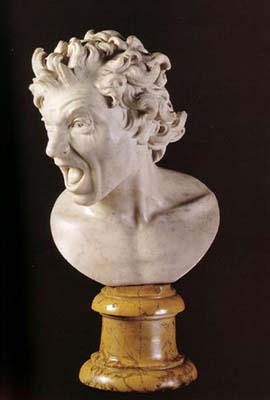
Damned Soul
This bust was created early in Bernini's career when the artist was twenty one years old. It shows a man's screaming face, his features contorted with a wild expression of terror or even agony.
This piece was commissioned alongside another bust Blessed Soul, which portrays a young beautiful woman looking up in blissful joy. When placed together, these sculptures juxtapose a duality of human emotion, the opposing spectrums between being blessed or being damned. As this piece looked down toward hell, the other represented looking up toward God.
Damned Soul is believed by some to be a self-portrait. Bernini would have looked in a mirror and some believe he even cut his arm to produce the agonized expression on his face. Although produced early in Bernini's career, these works brought together many elements that would remain present in all of Bernini's future works such as religious salvation, intense human emotion, and technical skill in sensual depictions of the human body.
This dramatic depiction of the flesh was also new in art, contrasting to previous Mannerist styles, which often attempted to recreate ancient Roman and Greek traditions. In contrast to this, Bernini and other Baroque artists like Caravaggio and Rubens paved the way for a new way of depicting the human body with a new focus on sensuality.
Marble Sculpture - Palazzo di Spagna, Rome
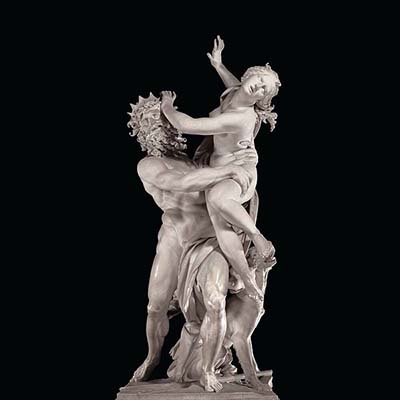
The Rape of Proserpina
This sculpture depicts a story from Ovid's Metamorphoses in which Pluto falls in love with the goddess Proserpina and abducts her, taking her to the underworld where he reigns as king. Pluto is shown with a regal crown and scepter while the three-headed dog, Cerberus, is behind ensuring no one interferes. Pluto grabs Proserpina around the waist and thigh while she struggles to escape; she is pushing away his head while her other arm reaches out with helpless abandon.
In this work Bernini shows his fascination with depicting scenes in dramatic mid-action, inviting the viewer to witness the piece and become fully absorbed. His son Domenico described it as an "amazing contrast of tenderness and cruelty," seen in the details of Pluto's fingers pressing into Proserpina's thigh, creating an extraordinary illusion as the hard and cold marble seems soft and delicate in contrast with the violence. Art historian Daniele Pinton points out that the work is characteristic of Bernini's sculpture in "depicting not a figure but an event." Bernini attempts to freeze a moment in time and the action is suspended in the midst of the drama. His work was also often created with the purpose of being shown in the round in a large space, so that people could walk around it and encounter it through various perspectives. This was highly innovative for the time and infused a breath of fresh air into the genre.
This work is now seen as a Baroque masterpiece and has been referenced by contemporary artists such as Jeff Koons who recreated a stainless steel sculpture in its likeness.
Marble Sculpture - Galleria Borghese, Rome
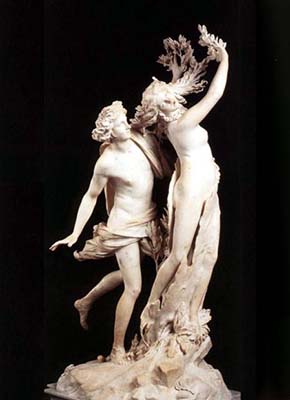
Apollo and Daphne
Apollo and Daphne was completed when Bernini was twenty-seven and is similar to his The Rape of Proserpina as it shows a moment of violence. It depicts the instance, from Ovid's Metamorphoses, in which Apollo, the God of Light and Poetry, is pricked with one of Cupid's arrows, causing him to fall madly in love with river nymph Daphne. Daphne was devoted to the goddess Diana and had pledged to remain a virgin for life, so when Apollo pursues her she calls to the river God for help. This sculpture shows the climax of the story when she is aided by the Gods and is transformed into a laurel tree to avoid Apollo's capture. According to the story, "Torpor seized on all her body, and a thin bark closed around her gentle bosom, and her hair became as moving leaves."
Bernini's mastery of movement and drama between the two beings was unparalleled in his time. His sculptures broke the tradition of previous Renaissance sculptures as Apollo's robe whirls around the figures encouraging the viewer to follow it around and the composition shows the progression of Daphne's transformation. Daphne is shown as a woman made of flesh and skin from behind, but only by walking around the sculpture can the viewer see that her hair and outstretched arm are growing leaves and roots. This creates a theatrical effect, a moment of intense action and emotion that shows Bernini's skillful handling of the marble.
Artist Peter Rockwell said that, "any sculptor who looks at Bernini's Apollo and Daphne can only come away astonished." His technical skill and innovation has inspired countless modern artists such as Ian Hamilton Finlay, who drew directly from this sculpture in his work of the same name.
Marble sculpture - Galleria Borghese, Rome
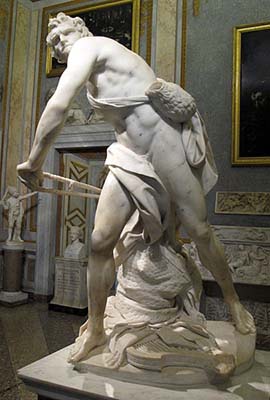
David
Bernini's sculpture of David depicts the Biblical moment just before the young man threw the stone that slew the giant Goliath, an action that would make him king. His body is twisted and his facial expression is one of concentration and tension. His eyes are fixed on the target and his body is in a stance ready to swing his arm and throw the stone, like a spring about to be released. Armor lies at his feet, referring to the Bible text, which states that David removed his armor to allow him freer movement, reflecting his complete trust in God's aid.
David was a popularly depicted subject by Renaissance artists and sculptors such as Donatello, Verrocchio, and Michelangelo. But Bernini's sculpture differed radically from the poised, forward-facing forms that were traditional. Also, instead of showing the moment after David has defeated Goliath, which was customary, he shows him about to fire.
This sculpture shows Bernini's characteristic portrayal of the decisive moment (an idea coined by the famous photographer Henri Cartier-Bresson, and practiced by many later artists). He shows the figure as part of a wider story by creating the illusion of movement through the figure's stance and facial expression. Art historian Emma Barker writes that Bernini's "twisting figures and deeply carved draperies defy the limits of niches or pedestals and cannot be bound or framed by a single view." Instead the viewer is encouraged to walk around the sculpture, taking it in from multiple angles to fully appreciate every detail.
David's face was believed by Bernini's son to be a self-portrait, which may be how he achieved the exact expression he wanted, giving us insight into how Bernini worked. This sculpture shows a key change between the Renaissance and Baroque. Renaissance artists previously worked from ancient sculptures whereas Bernini worked directly from life.
Marble Sculpture - Galleria Borghese, Rome
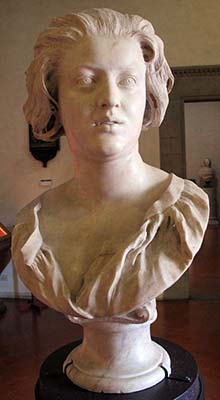
Portrait Bust of Costanza Bonarelli
This is one of many portrait busts by Bernini yet it is unique because it was not a commission; it was a "purely for pleasure" project for the artist. It depicts Bernini's lover Costanza in partial undress. Her slightly open mouth contributes a great sensuality to the portrait, as it would have been carved from life.
Costanza was married to Bernini's collaborator Matteo Bonarelli during their affair. To make matters worse, Costanza would go on to have an affair with Bernini's brother Luigi, which resulted in the artist ordering a servant to slash his lover's face. Because of the controversy, this piece has always fascinated viewers. But the real genius of the piece is in its showcasing of Bernini's specialty of creating a "speaking likeness" of a person caught in the act of talking, or expression, rather than merely posed. Bernini was reported to have said that "the best time to render the mouth is when [the subject] has just spoken or is just about to begin speaking; one should try to catch this moment."
The art historian E.H. Gombrich described his experience of seeing the bust in person: "When I saw it last in the museum in Florence, a ray of sunlight was playing on the bust and the whole figure seemed to breathe and come to life. Bernini has caught a transient expression which we are sure must have been most characteristic of his sitter." In Sarah McPhee's book, Bernini's Beloved, she writes that the bust "captures the riveting individuality of the sitter. The passion of her youth, the recklessness of her behavior, the intelligence that would see her to wealth and success are all suspended in the stone."
Marble bust - National Museum of Bargello, Florence
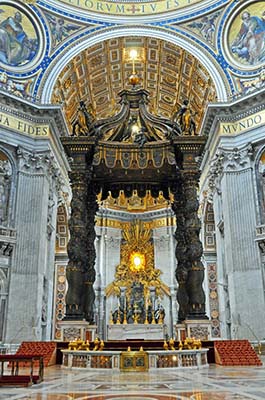
St. Peter's Baldachin
St. Peter's Baldachin is an elaborately curvaceous bronze canopy designed by Bernini within St. Peter's Basilica in Vatican City. The canopy covers the high altar of the basilica and is a focal point due to its large scale and ornate design. The work consists of four helical columns raised on marble plinths with four large angels in each corner. On the top of the canopy is a sphere and a cross, symbolizing Christ's redemption. The baldachin sits directly under the dome of the basilica and on top of St. Peter's tomb. By being placed in this position, it simultaneously draws attention to the heavenly realm above, the earthly realm of the church, and hell below. It draws attention to the vast scale of the church and the scale of the people within it, serving as a visual reminder of the vastness of God's creation compared to the human beings inhabiting it.
Baldachin was a collaborative work. His rival Francesco Borromini, his father Pietro, his brother Luigi, and other artists who contributed to the decorative elements assisted Bernini. This project sealed the artist's status as Rome's most prominent sculptor, and the fact that this piece was encompassed inside a Michelangelo-designed dome, solidified that career validation.
Bronze
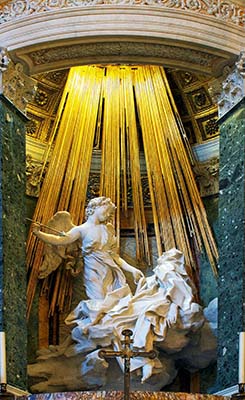
The Ecstacy of Saint Teresa
Cardinal Federico Cornaro commissioned this work for his family chapel. In it, we see the Spanish nun and mystic Saint Teresa of Avila. She is shown on a cloud, suggesting her ascension into heaven, with golden rays of light pouring down. A hidden window above the scene infuses it with natural light. A winged angel holds a spear about to be thrust into Teresa's heart as an expression of ecstasy floods her face. This work displays Bernini's technical brilliance and innovation in his manipulation of marble as the folds of Teresa's robes, rather than the controlled folds of classical sculptures, are shown whirling around Teresa contributing to the sense of movement.
Bernini drew from Teresa's own famous account about her religious experience after the spear pierced her heart, "leaving me all on fire with a wondrous love for God. The pain was so great that it caused me to utter several moans; and yet so exceedingly sweet is this greatest of pains that it is impossible to desire to be rid of it, or for the soul to be content with less than God." The ecstasy described in St. Teresa's writing has fascinated viewers and there has been disagreement over whether the sculpture depicts a sexual experience. Some scholars deny that this could have been Bernini's intention at the time, however the sensual depictions are faithful to Teresa's own account. Petersson argues that, "to see Teresa as an erotic figure limits her severely. Her entire being is consumed by a divine passion which possesses body, mind and soul at the same moment." Bernini depicts not just a spiritual ecstasy but also a physical ecstasy that is the result of divine intervention.
This work is one of Bernini's most unique as it is a complex ensemble of sculpture, painting, decoration, architecture, and light, creating a unified whole. The Cornaro family is also present, their sculptures looking onto the scene from the side creating a further theatrical effect. Art historian Robert Petersson writes that the chapel achieves "a single, overpowering effect, from the heavenly area at the top through the saintly and the mundane (including us) down to the zone of death at the bottom."
The work can be seen as over-theatrical but Gombrich argues that the artist deliberately cast aside tradition and depicted a moment of heightened emotion that had previously not been attempted by artists. This became a key feature of the Baroque period that was also present in works by Caravaggio, Rubens, and Velazquez.
Marble sculpture - Santa Maria Della Vittoria, Rome
Biography of Gian Lorenzo Bernini
Childhood
Gian Lorenzo Bernini was born in 1598, the sixth of thirteen children of Angelica Galante and Pietro Bernini. Bernini's childhood was spent in Naples and he began sculpting from an early age working closely with his father, a successful Mannerist sculptor who carried out prestigious commissions in Naples and later Rome. Bernini was a deeply religious Catholic and created his first work at the age of eight. His father encouraged his skill, recognizing early the prodigy he would become. In fact, he was presaged, "the Michelangelo of his age," according to Gian's son and biographer Domenico Bernini. This lifelong dedication to practice would lead to Bernini's development of his own style which would go on to greatly contribute to the Baroque movement.
Early Training and Work
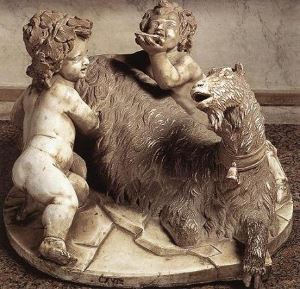
The Bernini family moved to Rome in 1606 as Pietro was invited by the Pope to work on the basilica Santa Maria Maggiore. Bernini's first sculpture The Goat Amalthea with the Infant Jupiter and a Faun was started when Bernini was eleven years old. It was reported that when Cardinal Maffeo Barbenini visited the Bernini family workshop he warned Pietro Bernini to be careful, as his son would soon surpass his father. This period had a significant impact on Bernini's artistic career, as Rome was a melting pot of artists of all types, from sculptors and painters to architects, masons and goldsmiths. Work for artists in Rome was flush during most of the seventeenth century as popes funded the modernization and rebuilding of the city.
Bernini's reputation for artistic mastery flourished in the city. Cardinal Scipione Borghese told his uncle, Pope Paul V, about Bernini's work which led to his employment by a succession of six Popes, a role held by Michelangelo before him. This established him within a solid career that would continue for life. Pope Urban VIII reportedly said to him, "you are made for Rome, and Rome for you."
Mature Period
Bernini's first mature sculpture was of Saint Lawrence, completed in 1617. It was described as an "act of pious devotion" to his patron saint and showcased the importance of religion and the theme of devotion, which continued throughout his artistic career. From 1618 to 1625, Bernini worked prolifically, creating masterpieces such as The Rape of Proserpina, David and Apollo and Daphne. Alongside these large-scale sculptures Bernini also created portrait busts, capturing what is now described as a "speaking likeness," or the capturing of a person in action or at the point of uttering words. He said that "the white marble has to assume the likeness of a person, it has to have color, spirit and life," which made his busts differ from more traditional forms and paved the way for a new style. In 1629, Bernini became the chief architect of the Fabric di San Pietro, the institution responsible for maintaining St. Peter's Basilica. In August of the same year Bernini's father died, but Bernini still produced, solidifying his period of dominance in Rome.
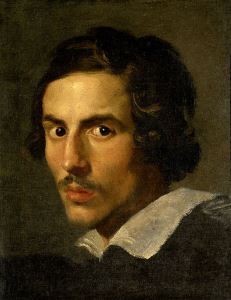
His association with the court of Rome lasted for fifty years along with close ties to each Pope. According to art historian Daniele Pinton, this was significant because "the history of art affords no other examples with such characteristics, of such creative continuity, for such a long time, by the work of a single artist." Bernini worked closely with his brother Luigi and was naturally entrepreneurial, remaining the dominant sculptor and architect in the city. He often clashed with Francesco Borromini, another noted architect who often lost out on work to Bernini due to the Pope's favoritism. Bernini's workshop was organized like a factory; he rarely refused commissions and delegated work to his assistants, even collaborating once with Borromini on St. Peter's Baldachin despite their rivalry.
Bernini had an affair with his assistant Matteo Bonarelli's wife Costanza, during which he created a bust of her. This pioneered a new era in European sculpture as busts were usually formal portraits reserved for tombs, and had not been used for informal portraits since Ancient Rome. The bust expressed the desire and intimacy between Costanza and Bernini, which would eventually end in scandal. Bernini was known to have a short temper and when he found out that Costanza was having an affair with his brother Luigi, he went after him in rage, beating him almost to death, then ordered a servant to slash Costanza's face. This was a great scandal in Rome at the time, yet due to his position as the Pope's friend, Bernini was not punished. Instead, he was ordered to marry, and thus pursued an arranged marriage with Caterina Tezio in 1639. They later had eleven children. In an ironic twist to this messy story, Luigi was banished from Rome and Costanza was imprisoned, convicted of adultery.
Late Period
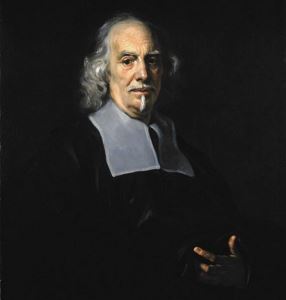
During Pope Alexander VII's pontificate (1655-67), Bernini attempted to transform Rome through a costly urban planning project. He managed to recreate the "glory of Rome" that had begun in the 15th century, and he focused on architecture including the piazza leading to St Peter's.
Bernini worked for a stint in Paris in 1665 and this was the only substantial amount of time he was away from Rome since arriving from Naples. He became a popular figure while in France, even being recognized as he walked Parisian streets. King Louis XIV had invited Bernini and other Italian architects to work on the Louvre Palace but Bernini's designs were rejected. He was open about his dislike for French culture and art, making it difficult to gain further commissions in Paris and Bernini's only artwork that remains from this time is a bust of King Louis XIV. After returning to Rome Bernini created an equestrian statue of Louis XIV but when it was delivered to Paris, Louis XIV was unhappy with it and had the head replaced.
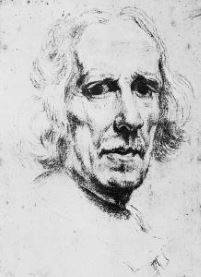
Back in Rome Bernini continued to work for Pope Alexander VII then Pope Clement IX, carrying out improvements for cathedrals and churches in the city. He also created Pope Clement IX's tomb monument and a statue of the successive pope Clement X. Bernini's final work was Salvator Mundi, finished in 1679. It is a marble sculpture of Christ, which he described as his "darling" created out of devotion. He died in 1680 at the age of eighty one and was buried alongside his parents in the Basilica di Santa Maria Maggiore.
The Legacy of Gian Lorenzo Bernini
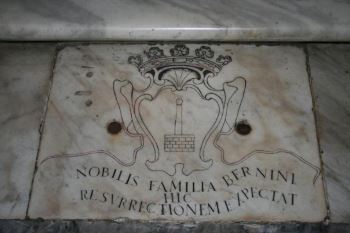
When Bernini was alive his work was admired for its innovative presentation of sculpture in new ways, pioneering a new era in European sculpture that became synonymous with the Baroque movement. Leopolgo Cicognara wrote that "perhaps no one, before or after Gian Lorenzo, has left so deep a mark on such a long period of art history; Bernini is synonymous with the Baroque." His work also went beyond what art was expected to do - his work was designed to affect viewers with all the senses and could aid religious experiences, not just on a rational level but also on an emotional one.
He had a major impact on the city of Rome, shaping its architecture and leaving a mark that few artists have since. Bernini is part of a succession of great Italian sculptors placed alongside Donatello, Michelangelo, and Canova.
Bernini was not without his critics. By the end of his life there was a reaction against the extravagance of his work. Scholars like Johann Winckelmann believed art should appeal to the mind whereas Bernini's art appealed excessively to the senses. In fact, "Baroque" was initially deemed a derogatory term in regards to the theatrical nature of Bernini's and other artists' work. However, by the end of the 19th and early 20th centuries, art historians began re-evaluating Bernini's work, writing about the Baroque movement positively, and in the last few decades there have been multiple exhibitions of Bernini's work, placing him as the indisputable father of Baroque sculpture.
Bernini also had a significant impact on future artists, as his focus on sensuality, the flesh, and the human body paved the way for many innovators. In particular, the German Expressionists were highly influenced by Bernini and Baroque art due to their focus on the human experience and intense emotion. Contemporary artists have also referenced Bernini's work such as Ian Hamilton Finlay and Jeff Koons. His technical expertise continues to be studied and his insistence that beauty should be found in observing nature instead of studying classical statues or Renaissance paintings was a move away from the traditional approach to making art, which continued to be practiced long after his death.
Influences and Connections

-
![Michelangelo]() Michelangelo
Michelangelo -
![Donatello]() Donatello
Donatello -
![Leonardo da Vinci]() Leonardo da Vinci
Leonardo da Vinci - Pietro Bernini
- Luigi Bernini
- Pietro Bernini
- Luigi Bernini
- Giulian Finella
- Andrea Bolgi
-
![Jean-Antoine Watteau]() Jean-Antoine Watteau
Jean-Antoine Watteau -
![Francisco Goya]() Francisco Goya
Francisco Goya -
![Jacques-Louis David]() Jacques-Louis David
Jacques-Louis David - Giovanni Battista Tiepolo
- Francesco Guardi
- Giuliano Finelli
- Andrea Bolgi
- Nicodemus Tessin
Useful Resources on Gian Lorenzo Bernini
- BerniniOur PickBy Andrea Bacchi and Anna Coliva
- Bernini and the Excesses of ArtOur PickBy Petersson, Robert Torsten
- Bernini: Sculptor and ArchitectOur PickBy Daniele Pinton
- The Life of BerniniBy Fillipo Baldinucci
- Bernini: Genius of the BaroqueBy Charles Avery
- Bernini: His Life and His RomeBy Franco Mormando
- The Art of EcstasyBy Robert T. Petersson
- Art and Visual Culture 1600-1850: Academy to Avant-GardeBy Emma Barker / Chapter 1 - Bernini and Baroque Rome
- The Story of ArtBy E.H. Gombrich / Chapter 21: Power and Glory I: Italy, Later Seventeenth and Eighteenth Centuries
- Concepts of Modern Art: From Fauvism to PostmodernismBy Nikos Stagnos / For the influence of Baroque art on Modern art see chapter on Expressionism
 Ask The Art Story AI
Ask The Art Story AI